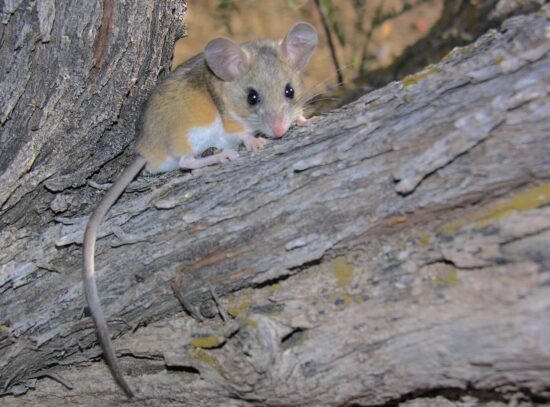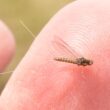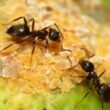Nobody wants to share their home with unwanted guests, especially ones that can make you sick. Deer mice might look cute with their big eyes and fluffy tails, but they carry a dangerous virus called hantavirus that can be deadly to humans. If you’re dealing with these little critters, you need to act fast and do it safely.
Unlike regular house mice, deer mice live mostly outdoors in wooded areas. They have brown or gray fur with white bellies and distinctive two-toned tails that are dark on top and white underneath. These mice are excellent climbers and can get into homes through tiny gaps you might not even notice.
The biggest concern with deer mice is hantavirus, which kills about 4 out of every 10 people who get infected. This virus spreads when you breathe in dust that contains mouse droppings, urine, or saliva. That’s why getting rid of deer mice safely is so important.
This guide will walk you through some of the best methods for getting rid of deer mice, from sealing up your home to setting traps and knowing when to call in the pros. Remember, the key to success is using multiple methods together and always putting safety first.
- Designed to humanely capture mice without causing any harm
- The trap cage is easy to set up and use
- The trap cage has a large capacity, allowing it to trap multiple mice at once
- Made of high-quality materials that are durable and reusable
1. Seal Entry Points and Block Their Way In
The best way to deal with deer mice is to stop them from getting inside in the first place. These sneaky rodents can squeeze through holes as small as a quarter inch, which is about the size of a dime. That tiny gap under your door or that crack in your foundation? Perfect mouse highway.
Start by walking around your home with a flashlight and look for any openings. Pay special attention to areas where pipes and wires enter your house. These spots are mouse magnets because they’re often not sealed properly.
When you find holes, don’t just stuff them with whatever’s handy. Mice can chew through most materials, but they hate steel wool. Use steel wool combined with caulk or cement to seal gaps. For larger holes, use quarter-inch wire mesh or metal flashing.
Don’t forget about your fireplace chimney. Deer mice are excellent climbers and often use chimneys as their personal elevator into your home. Install a chimney cap or screen when you’re not using your fireplace.
Also check windows, doors, and foundation cracks. Replace old weather stripping and fix loose mortar around basement windows. Remember, if you can slide a pencil through a gap, a mouse can probably squeeze through it too.
2. Use Snap Traps for Quick Results
When it comes to getting rid of deer mice that are already inside, snap traps are your best friend. They work fast, they’re affordable, and they don’t leave you with stinky dead mice hiding in your walls like poison does.
Not all snap traps are created equal. The Victor Snap Trap model 325 with the expanded trigger catches 53% of mice compared to only 37% for regular traps. The Mini Rex Mouse Trap has a special bait cup that forces mice to really commit to getting the food, making it super effective.
Placement is everything with traps. Set them along walls where you’ve seen mouse droppings or gnaw marks. Mice like to run along edges, so put the trigger end against the wall. In areas with lots of mouse activity, use two traps side by side with about an inch between them. This catches mice that try to jump over the first trap.
For bait, forget what you’ve seen in cartoons. Mice don’t actually love cheese that much. Instead, use a pea-sized amount of peanut butter or hazelnut spread. You can also try dental floss or cotton balls since mice love these materials for building nests.
Set out plenty of traps. Studies show that more mice get caught on the first night than any other time, so don’t be stingy. Twelve traps for just a couple of mice isn’t too many.
- Designed to humanely capture mice without causing any harm
- The trap cage is easy to set up and use
- The trap cage has a large capacity, allowing it to trap multiple mice at once
- Made of high-quality materials that are durable and reusable
3. Try Electronic Traps for Easy Cleanup
If the thought of dealing with dead mice in regular traps makes you squeamish, electronic traps might be perfect for you. These high-tech devices deliver a quick electric shock that kills mice instantly and humanely.
Electronic traps are super easy to use. Just add bait, turn them on, and wait. When a mouse goes inside to get the food, it steps on metal plates that deliver the shock. Most models have a light that tells you when you’ve caught something.
The Victor Electronic Mouse Trap is one of the most popular options. Some models can catch multiple mice before you need to empty them, which is handy if you’re dealing with a bigger problem.
The downside? These traps cost more upfront than regular snap traps, and they only work indoors where you can plug them in. They also don’t work well in very cold or wet conditions. But for many people, the convenience and cleaner process make them worth the extra cost.
Remember that electronic traps are designed for small rodents like mice. If you think you might have rats, you’ll need a different approach.
4. Set Up Bait Stations When Trapping Isn’t Enough
Sometimes snap traps and electronic traps aren’t enough, especially if you have a lot of mice. That’s when professional-grade bait stations come in handy. These are special containers that hold poison bait safely away from kids and pets.
Only use rodenticides that are approved for deer mice, like chlorophacinone and diphacinone. Avoid zinc phosphide unless you absolutely have to, because it’s extremely dangerous for pets and children.
The key to using bait stations safely is placement. Put them in areas where mice are active but where children and pets can’t reach them. Think behind appliances, in basements, or in attics. The stations should be tamper-resistant, meaning kids can’t easily open them.
Here’s the big downside: if mice eat the poison and then die inside your walls, you’re in for weeks or even months of terrible smells. The dead mouse will bloat and leak, attracting flies and creating a real mess. That’s why many experts recommend traps first and poison only as a last resort.
If you do use bait stations, check them regularly and follow all label directions exactly. This isn’t the time to wing it or use more than recommended.
5. Try Natural Deterrents But Keep Expectations Realistic
- Plant-based peppermint oil formula repels pests naturally
- Safe to use around pets, kids, and indoor living spaces
- Great for garages, attics, baseboards, and outdoor areas
- Fresh mint scent with long-lasting protection
Many people want to know how to get rid of deer mice using natural methods, and while these won’t solve a serious infestation, they can help as part of a bigger plan.
Peppermint oil is the most popular natural deterrent. The strong menthol smell irritates mice and can make them avoid certain areas. Mix two teaspoons of peppermint oil with one cup of water in a spray bottle and spray it around entry points and areas where you’ve seen mice.
The catch? Peppermint oil doesn’t last long. The smell fades quickly, especially outdoors, and mice can get used to it. You’ll need to reapply it weekly, and it works better for preventing mice than getting rid of ones that are already settled in.
Ultrasonic repellers plug into your wall and send out high-frequency sounds that supposedly bother mice. Some people swear by them, but the science is mixed. The sound waves don’t go through walls, so you need one in each room. Also, mice that have already found food and shelter in your home will often just ignore the noise.
Other natural options include citronella oil, eucalyptus oil, and even vinegar. These might help keep mice away from specific areas, but don’t count on them to solve your problem on their own.
6. Remove What Attracts Them in the First Place
Getting rid of deer mice means making your home less appealing to them. Mice need three things: food, water, and shelter. Take away these basics, and they’ll look somewhere else to live.
Start with food storage. Mice only need about three grams of food per day to survive. That’s less than a teaspoon. Those few crumbs under your stove or some spilled cereal in your pantry can feed a mouse family for days.
Store all food in containers that mice can’t chew through. Glass jars, metal containers, and thick plastic bins with tight lids work great. This includes pet food, bird seed, and anything else that smells good to a mouse.
Clean up crumbs and spills right away. Mice have an amazing sense of smell and can detect food from far away. Sweep and mop your floors regularly, and don’t forget to clean under appliances where crumbs like to hide.
If you have bird feeders, take them down temporarily if you suspect a mouse problem. The seeds that fall on the ground are like a buffet for mice. Same goes for pet food left outside overnight.
Don’t give mice good nesting spots either. Store boxes and belongings off the floor and away from walls. Clear out clutter from basements, attics, and storage areas. Remove old newspapers, fabric scraps, and other soft materials that mice love to use for building nests.
7. Make Your Yard Less Mouse Friendly
Deer mice live outdoors most of the time, so making your yard less attractive can prevent them from moving into your house when the weather gets cold.
Keep grass cut short and trim bushes and tree branches away from your house. Mice feel safer when they have cover to hide under, so removing their hiding spots makes them nervous about hanging around.
Get rid of brush piles, wood stacks, and debris near your home. If you need to store firewood, keep it at least 20 feet from your house and raise it off the ground on a rack.
Pay special attention to douglas fir trees if you live in the Pacific Northwest. Deer mice absolutely love these trees, so keep them trimmed back from your house if possible.
Create a barrier around your home’s foundation using three inches of gravel. This makes it harder for mice to dig burrows close to your house. For extra protection, you can install metal flashing that goes six inches into the ground and rises 12 inches above ground level.
Don’t forget about outbuildings like sheds, garages, and barns. These structures often have more gaps and cracks than your main house, making them perfect mouse hotels. Apply the same sealing and cleaning principles to these buildings.
8. Clean Up Mouse Messes Safely
This might be the most important section of this entire guide. Cleaning up after deer mice isn’t like cleaning up after regular house mice. Because deer mice carry hantavirus, you could literally be risking your life if you don’t do this right.
Never, ever vacuum or sweep mouse droppings. This stirs up dust that might contain the virus, and you could breathe it in. Instead, you need to wet everything down first with a disinfectant solution.
Mix one and a half cups of household bleach with one gallon of water. Spray this solution on all mouse droppings, nests, and dead mice. Let everything soak for at least 10 minutes. The bleach kills the virus and keeps dust from flying around.
Wear the right protective gear. You need rubber gloves, a respirator with HEPA filters, and eye protection. Regular dust masks won’t protect you from viruses. If you’re cleaning up a big mess, wear disposable coveralls and shoe covers too.
After everything has soaked in the bleach solution, use damp paper towels or rags to wipe up the mess. Put everything in plastic bags, seal them tight, and throw them away. Clean the area again with the bleach solution and let it air dry.
If you find a lot of mouse droppings or suspect a big infestation, don’t try to clean it yourself. Call your local health department or a professional cleanup service. Some messes are just too dangerous for DIY cleaning.
9. Keep Watching for Signs They’re Coming Back
Getting rid of deer mice isn’t a one-time job. These persistent little animals will keep trying to get back in, especially during cold weather. That’s why you need to stay alert and check for signs of new activity.
Set up a regular inspection schedule. Check your basement, attic, garage, and other quiet areas at least once a month. Look for fresh droppings, which are dark and shiny when new. Old droppings turn gray and crumbly.
Watch for gnaw marks on wires, wood, and plastic. Fresh gnaw marks are light colored and have sharp edges. You might also notice a musky smell in areas where mice have been active.
Listen for scratching or scurrying sounds in walls and ceilings, especially at night when mice are most active. If you hear these noises, you probably have new visitors.
Keep a few traps set in areas where you’ve had problems before. Check them weekly and replace old bait. Even if you don’t catch anything, you’ll know right away if mice come back.
Don’t forget about seasonal patterns. Deer mice don’t hibernate, but they do look for warm places to spend the winter. Be extra vigilant in fall and early winter when mice are most likely to try moving indoors.
10. Know When to Call the Professionals
Sometimes, despite your best efforts, you need to call in professional pest control. Certain situations are just too dangerous or complicated for DIY methods, especially when dealing with deer mice and the hantavirus risk.
Call professionals if you find a lot of mouse droppings or suspect a heavy infestation. Professional exterminators have the right safety equipment and training to handle dangerous cleanups. They also have access to stronger treatments that aren’t available to regular homeowners.
Professional pest control companies use something called Integrated Pest Management, or IPM. This means they don’t just set a few traps and call it done. They inspect your entire property, identify exactly what type of mice you have, seal entry points, and create a custom treatment plan.
Expect to pay between $150 and $450 for a one-time professional treatment. Annual pest control plans that include mice and other pests typically cost $320 to $720 per year. While this might seem expensive, remember that professional exterminators can take 30 to 60 days to eliminate even a small infestation, and they have the experience to do it safely.
Look for pest control companies that are licensed and have experience specifically with deer mice. Ask about their safety protocols for hantavirus and what kind of warranty they provide. A good company will guarantee their work and come back for free if mice return within a certain time period.
Don’t wait too long to call for help. The longer you have deer mice in your home, the more dangerous the situation becomes and the harder they are to eliminate.
Wrapping Up Your Battle Against Deer Mice
Learning how to get rid of deer mice takes patience, persistence, and most importantly, proper safety precautions. The most effective approach combines sealing entry points, setting traps, removing food sources, and staying vigilant for signs of return.
Remember that exclusion is your best long-term strategy. A single unsealed gap can undo all your other efforts. Take the time to thoroughly seal your home, and check those seals regularly for damage.
When it comes to active removal, snap traps remain the gold standard. They’re effective, affordable, and don’t create the odor problems that come with poison. Electronic traps are a good alternative if you want easier cleanup.
Never forget about safety when getting rid of deer mice. The hantavirus risk is real and potentially deadly. Always wear proper protective equipment, use bleach solutions for cleanup, and don’t hesitate to call professionals for major infestations.
The key to success is using multiple methods together rather than relying on just one approach. Seal entry points AND set traps AND remove food sources AND monitor for new activity. This comprehensive strategy gives you the best chance of keeping your home mouse-free.
Most importantly, don’t get discouraged if you don’t see immediate results. Even professional exterminators need weeks or months to completely eliminate a deer mouse problem. Stay consistent with your efforts, and you’ll eventually win the battle against these unwanted houseguests.




